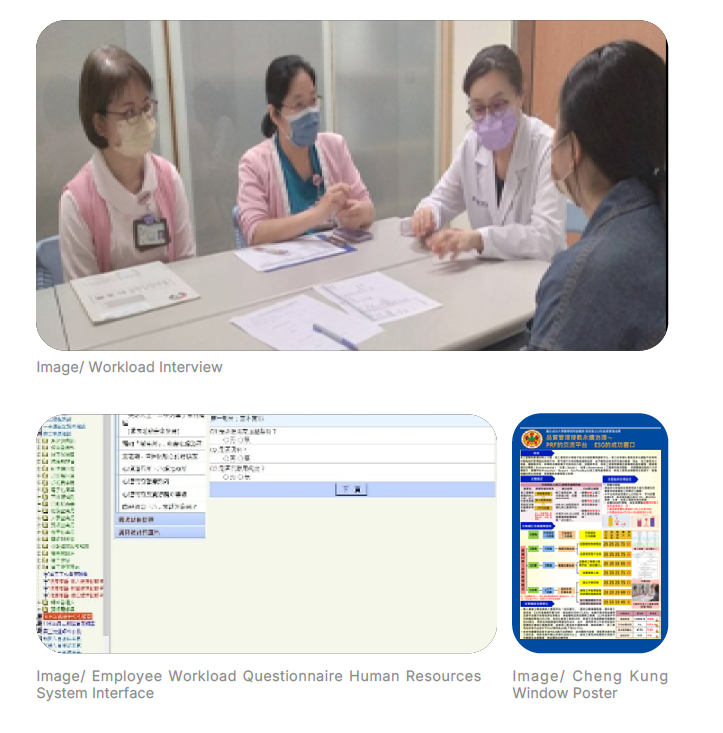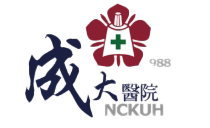Workplace Safety and Health
Occupational Safety and Health System
To promote and implement occupational safety and health initiatives, the Hospital has established the Occupational Safety and Health Management Guidelines in accordance with the Occupational Safety and Health Act and other relevant regulations. The occupational safety and health management practices referred to in these Guidelines encompass various management measures designed to prevent occupational accidents, maintain radiation safety within the hospital premises, ensure environmental quality and hygiene, safeguard personnel safety and health, and create a comfortable working environment. However, the Hospital has not yet obtained occupational safety-related certifications such as ISO 45001 or TOSHMS, but plans to implement them in the future.
The occupational safety and health responsibilities of each relevant unit of the Hospital are as follows:
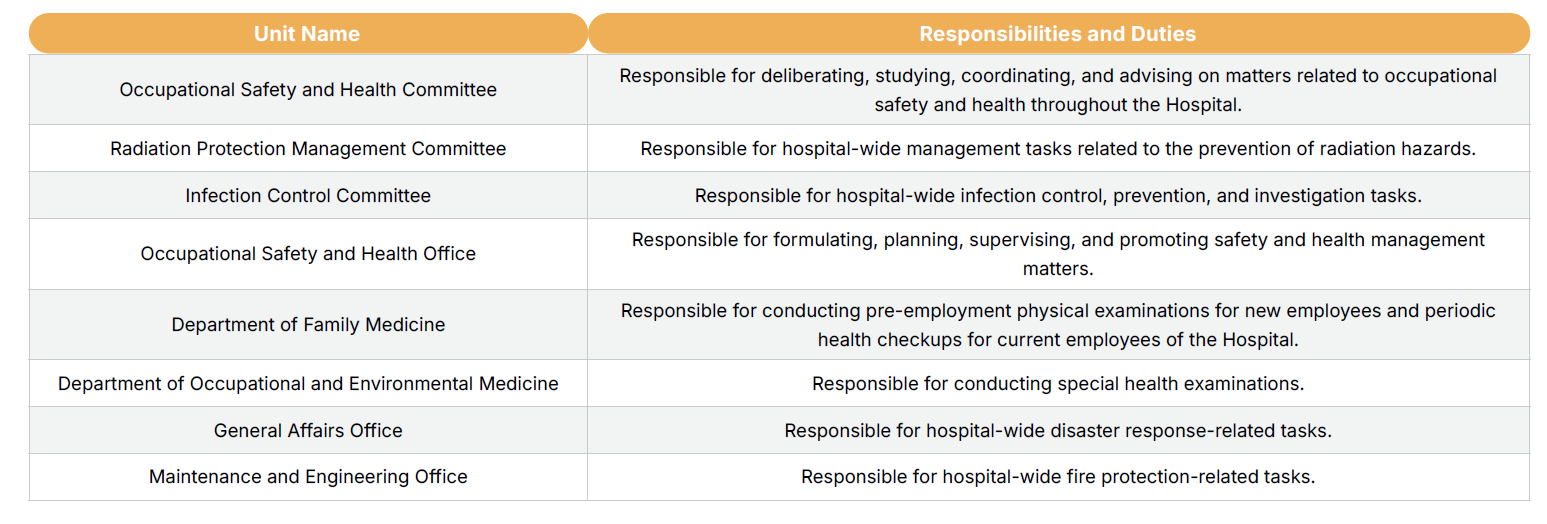


-
Occupational Safety and Health Committee
To comprehensively promote workplace safety and health management, NCKU Hospital has established a robust system and process in accordance with relevant regulations, and has formed the Occupational Safety and Health Committee. The Committee is chaired by a Vice Superintendent, with one Deputy Chairperson concurrently served by another Vice Superintendent appointed by the Superintendent, and includes one Executive Secretary. Members consist of supervisors from various units, occupational safety and health personnel, related engineering and technical personnel, medical and nursing personnel providing labor health services, and labor representatives. Currently, the Committee comprises 21 members, including 7 labor representatives and 14 employer representatives, with labor representatives accounting for 33% of the total membership. The Committee holds meetings quarterly to jointly deliberate, coordinate, plan, and make decisions with the management on occupational safety and health-related issues. Its duties include deliberating, studying, coordinating, and advising on matters related to occupational safety and health throughout the Hospital.
To ensure the workplace safety and health of all personnel, NCKU Hospital has established a comprehensive safety and health management mechanism for contractors. All contractors are required to comply with the “Contractor Safety and Health Management Manual” and adhere to infection control and related hygiene regulations to ensure that operations meet the Hospital's safety standards. In addition, a hazard communication and risk assessment mechanism is implemented based on the operational risks. Through the signing of the “Contractor Operational Safety and Health Affidavit,” the Hospital strengthens the identification and control of potential risks. Meanwhile, the Occupational Safety and Health Office regularly convenes contractor coordination meetings to communicate and exchange information on safety policies, regulatory advocacy, occupational incident case analyses, and improvement of deficiencies. These efforts effectively enhance contractors’ awareness and professionalism regarding safety and health, thereby improving overall operational safety quality and cooperation efficiency.
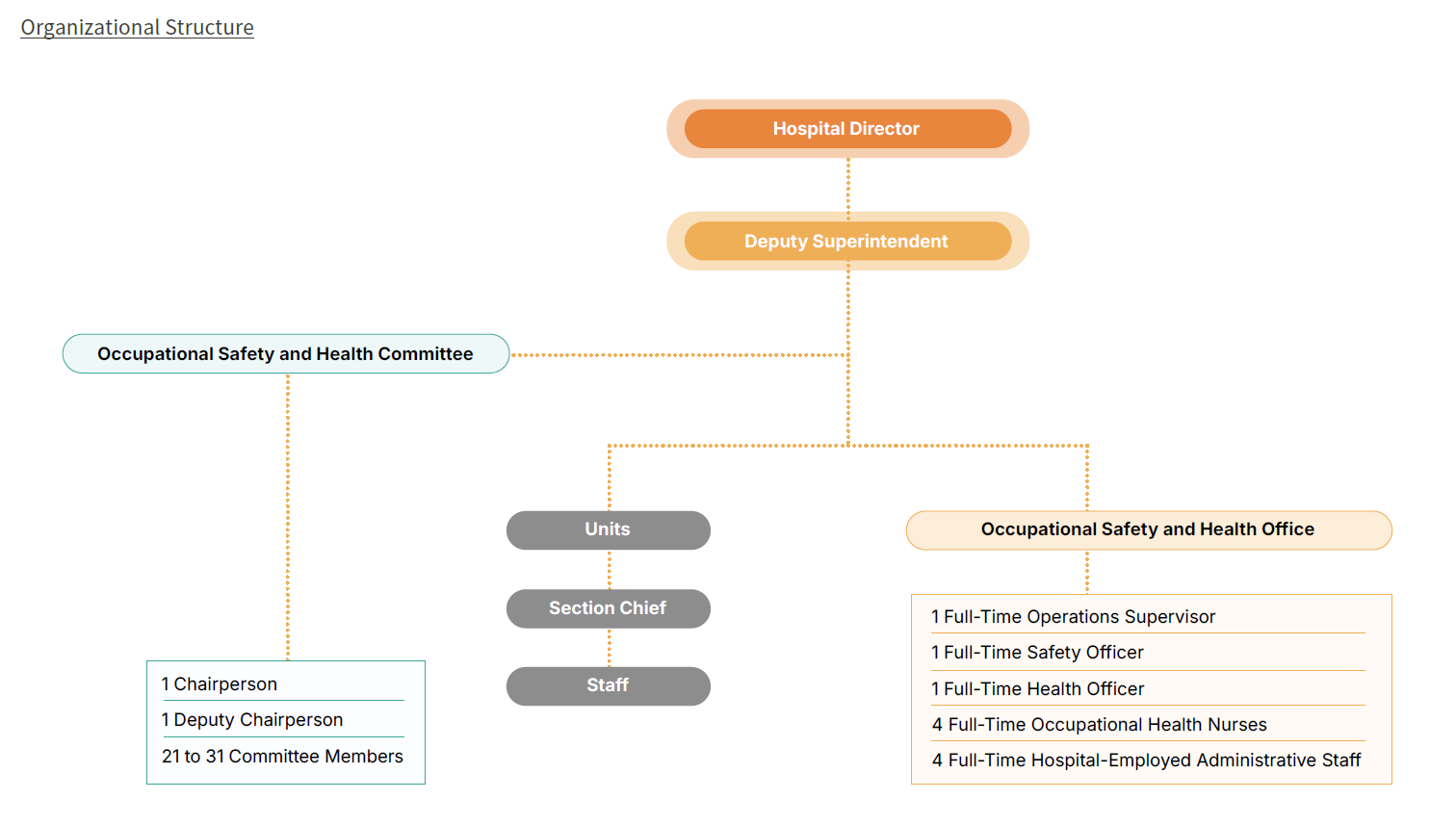
-
Training and Education
To enhance employees’ professional competencies and workplace safety awareness, NCKU Hospital has established the “In-service Personnel Training Program.” Based on different job categories and levels of occupational risk, the Hospital plans and implements annual continuing education courses. The training content covers topics such as occupational safety and health, infection control, and emergency response, ensuring that employees possess up-to-date knowledge and response capabilities, thereby improving overall medical quality and workplace safety. The training items for various job categories and risk levels are as follows:
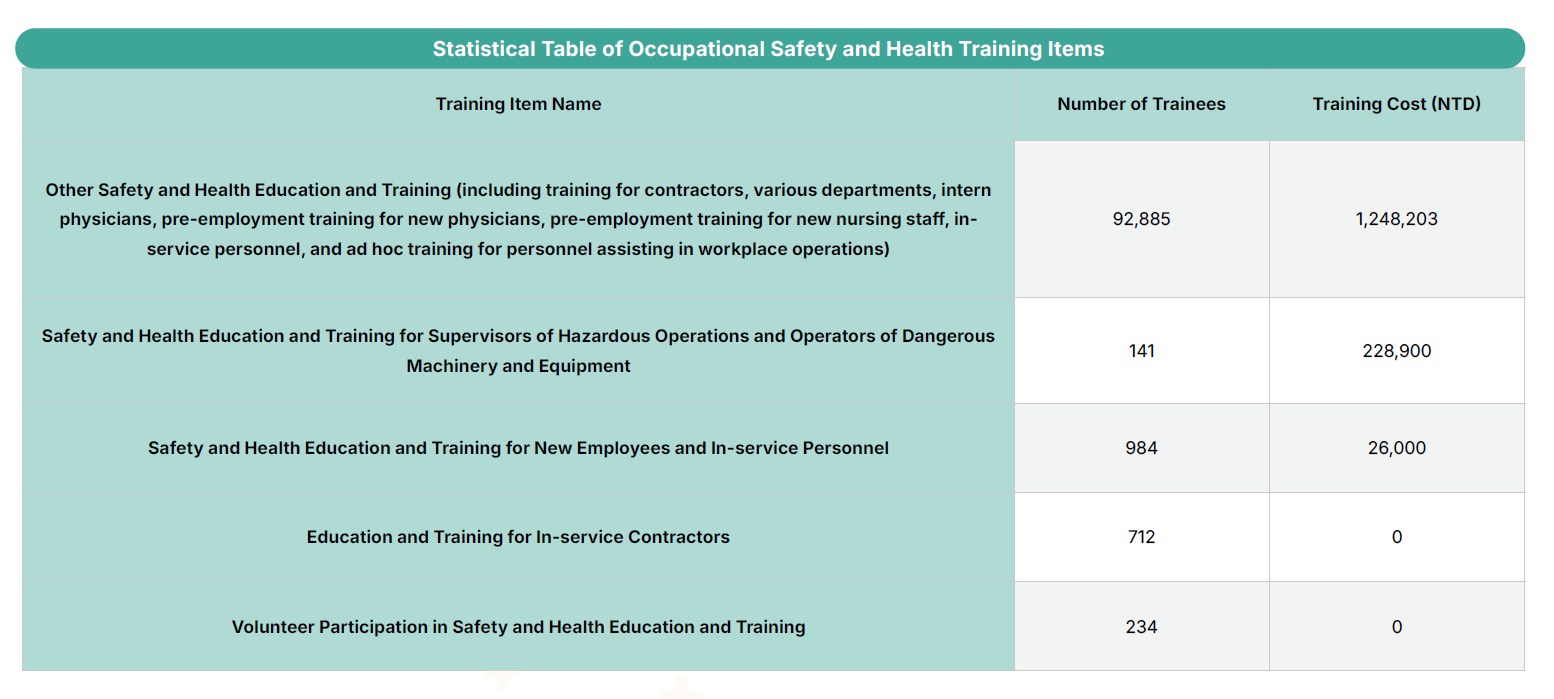
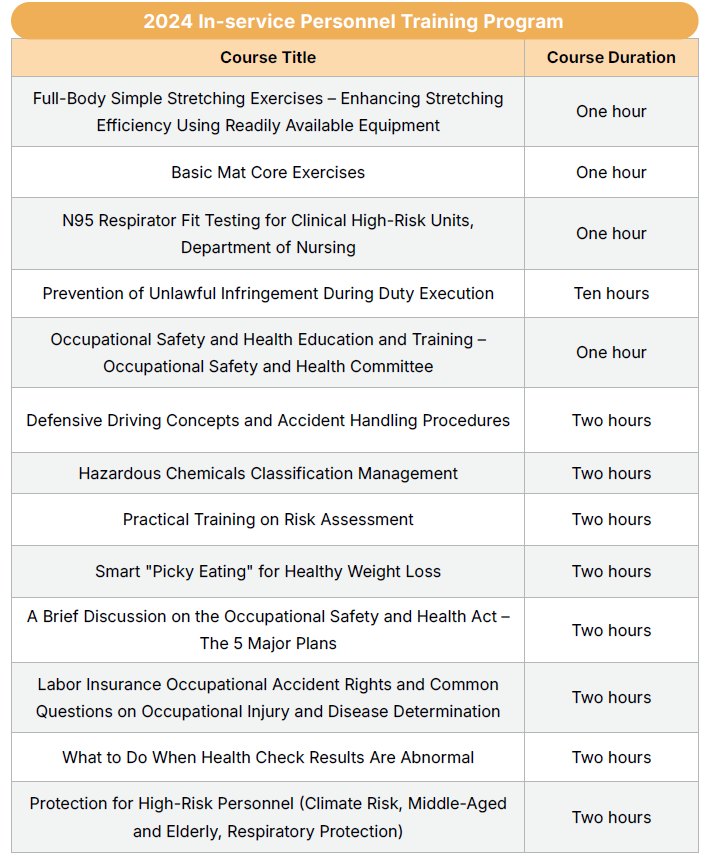
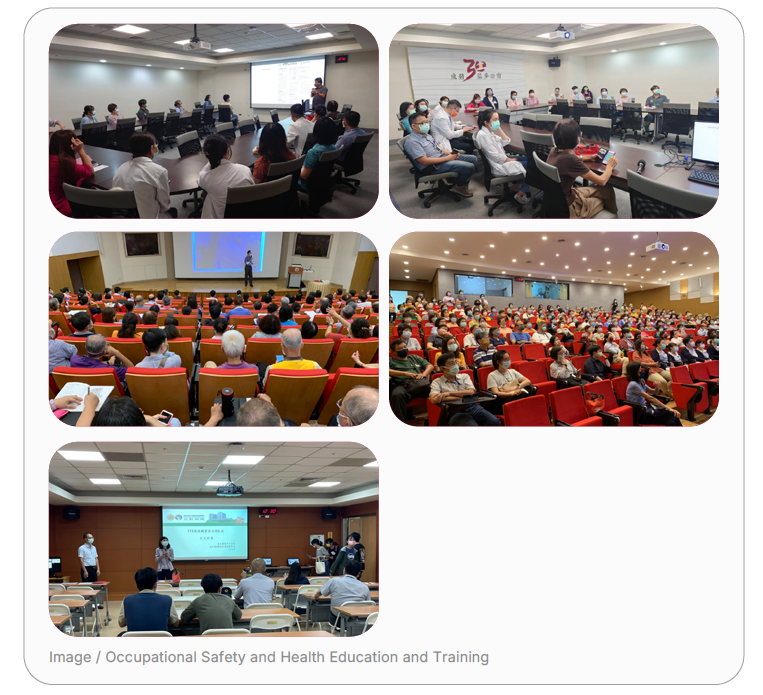
Our hospital's occupational safety and health courses combine in-person training with an online learning system to ensure that all personnel in the workplace can successfully complete the training. Course content is tailored according to job risks and responsibilities, with regular assessments of training effectiveness and needs. We continuously improve educational resources, striving to create a safe, healthy, and efficient medical work environment. In 2024, a total of 94,956 participants, including contractors, received occupational safety training, with training expenses amounting to NT$1,503,103.
Safe Working Environment
-
Occupational Safety Risk Assessment
NCKU Hospital incorporates all work activity areas, including locations, zones, equipment, and both routine and non-routine operations, into the scope of occupational safety and health management. The management targets not only include all hospital employees but also all external vendors, contractors, and non-employee workers operating within the hospital premises. The management coverage rate is 100%, ensuring that all work activities comply with safety regulations.
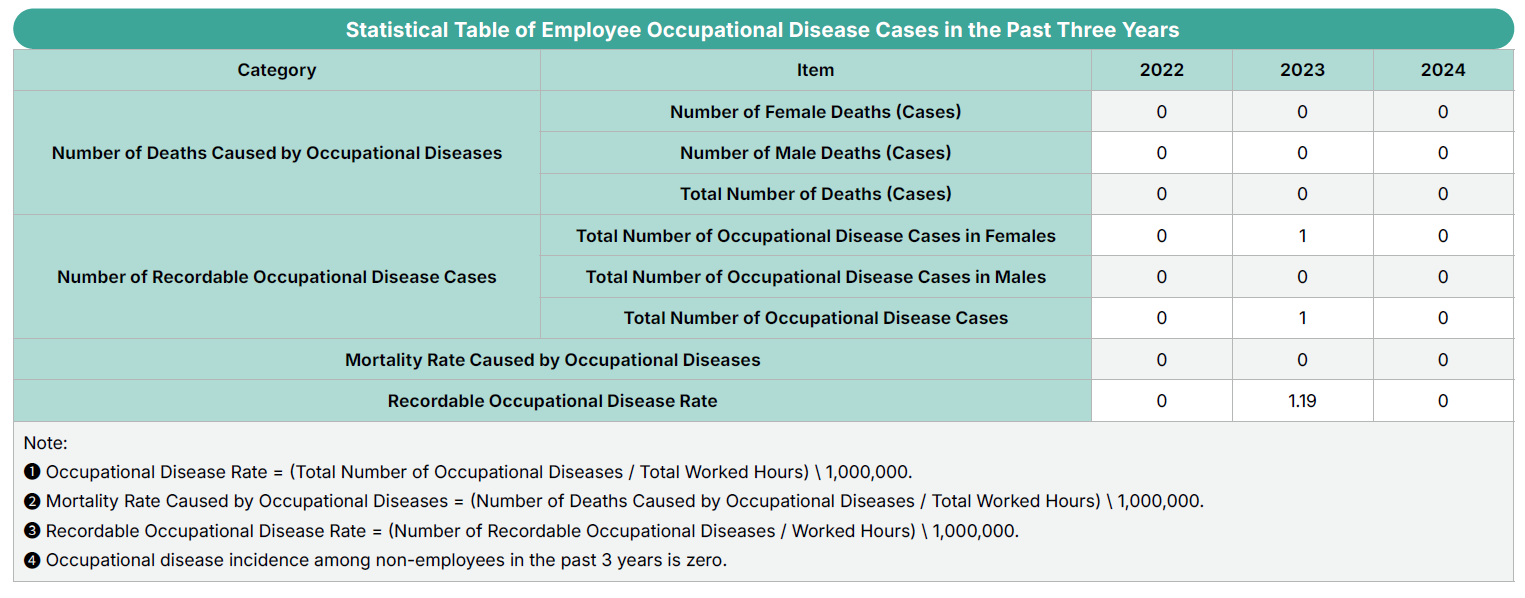
-
Occupational Accident Handling and Follow-Up
To effectively identify and manage occupational safety and health risks involved in operations, NCKU Hospital has established the “Hazard Identification, Risk Assessment, and Determination of Control Measures Standard.” This standard systematically identifies and assesses various hazards that may arise in the work environment and personnel activities, including physical, chemical, biological, and ergonomic hazards, to plan reasonable and feasible control measures that reduce safety and health impacts on employees, contractors, and related third parties. All operations undergo annual risk assessments according to this standard, and the implementation status is reported quarterly to the Occupational Safety and Health Committee.
In 2024, the hospital identified a total of 41 high-risk operations, of which 38 have been improved, achieving a risk improvement completion rate of 92.7%, demonstrating the hospital’s determination to continuously enhance safety management effectiveness. Regarding occupational accident incidents, the hospital has also established the “Work Guidelines (including Employee Accident Prevention Measures),” the “Occupational Accident Handling and Investigation Standard,” and the “Guidelines for Employee Occupational Accident Condolences and Medical Subsidies” as the basis for accident handling and subsequent care. After an incident occurs, the hospital immediately initiates an investigation, records relevant information, and reports to the Occupational Safety and Health Committee for case-by-case discussion and deregistration as a basis for continuous improvement.
Various safety management measures are implemented in the hospital’s high-risk areas, including safety inspections and environmental monitoring. The Occupational Safety and Health Committee convenes regularly to review and follow up on the implementation of automatic inspections, establish an incident reporting and investigation mechanism, and analyze the causes of occupational accidents to effectively prevent recurrence. Specific measures include having the supervisor of the incident unit attend the Occupational Safety and Health Committee to discuss and review case reports. For accident causes, such as presentations on cuts or falls, improvement measures are discussed and, upon committee approval, the cases are deregistered. Accident prevention measures are announced quarterly for public awareness.
In 2024, the hospital reported no cases of occupational disease, reflecting concrete results in workplace health promotion, hazard prevention, and occupational risk management, and also demonstrating the institution-wide emphasis and effort on employee health protection.
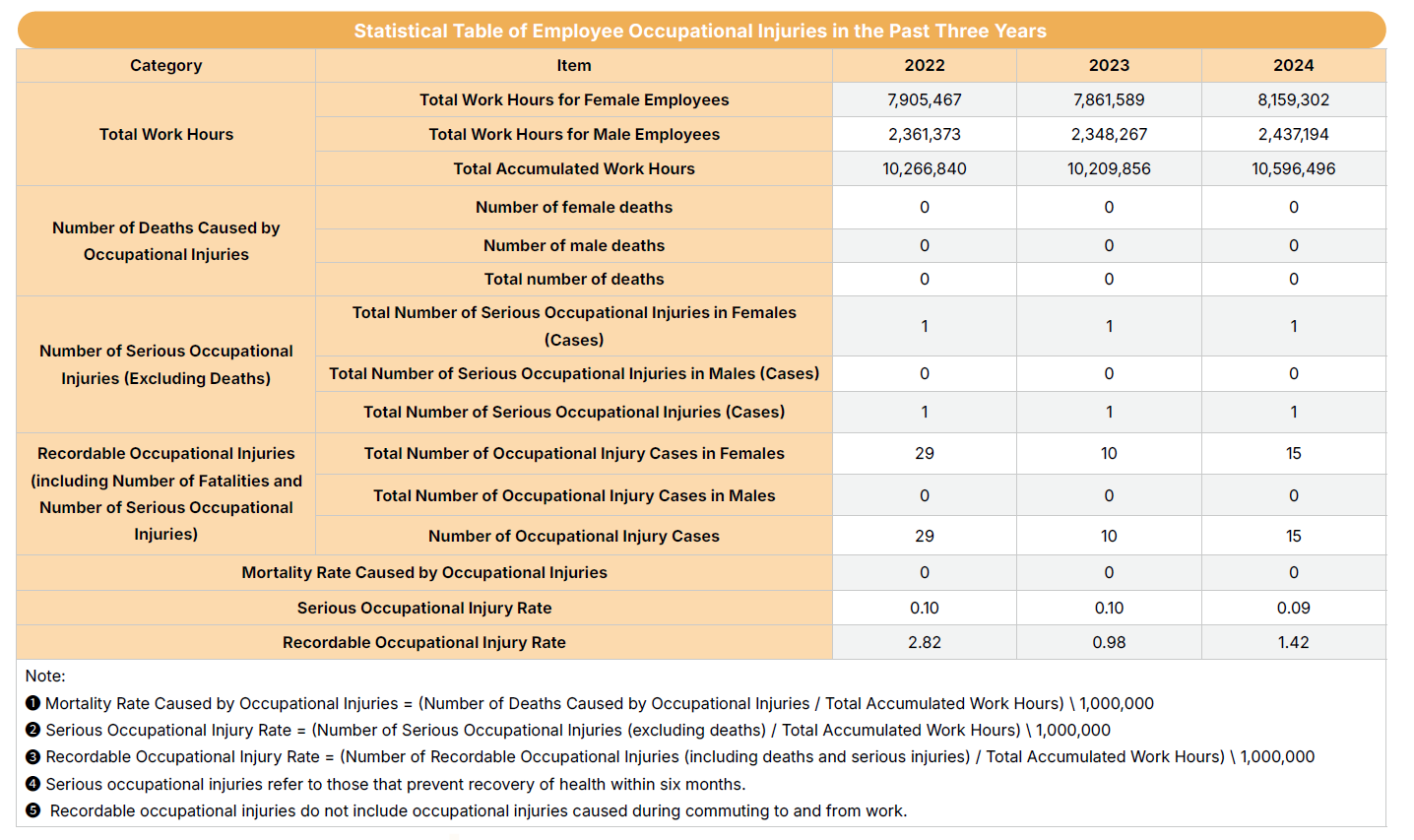
Employee Health Management
NCKU Hospital values employee health and workplace safety, clearly requiring new hires to complete the corresponding category of physical examination according to their job nature before starting work. Through the annual health check system, the hospital continuously monitors employee health status. Based on the examination results, four dedicated health service nurses provide individualized health follow-up and management services, assisting with work condition adjustments when necessary to prevent occupational diseases. Additionally, the hospital’s interdisciplinary professional team, including the Departments of Family Medicine, Occupational and Environmental Medicine, Nutrition, and the Labor Safety Office, jointly analyzes health check results to plan and promote various health promotion activities, continuously creating a safe, healthy, and friendly workplace environment.

-
Employee Health Check
The hospital currently has 5,047 employees, of whom 355 engage in operations with special health hazards. According to Article 3 of the Labor Health Protection Regulations, the hospital has assigned one dedicated employee health service physician and four dedicated employee health service nurses responsible for employee health management and protection. New hires must complete a physical examination before starting work based on the nature of their department. The examination targets include general employees and special operations workers to ensure workplace health and operational safety.
For current employees, the primary health check targets in 2024 are civil servants aged 40 and above, all personnel aged 65 and above, and special operations workers. Health checks are conducted in accordance with the Labor Health Protection Regulations, with special attention to those engaged in work involving special health hazards such as ionizing radiation, lead, noise, dust, formaldehyde, and manganese. This also includes personnel in dietary services, ethylene oxide, dialysis rooms, environmental management, laboratories, and chemotherapy operations, who undergo regular health checks. The hospital’s health check items exceed regulatory requirements. For example, employees over 40 receive additional tests including a full blood count, hepatitis B surface antigen and antibody, hepatitis C virus antibody, Serum Glutamic Oxaloacetic Transaminase (SGOT), total bilirubin, uric acid, limb blood flow and pressure measurement, electrocardiogram, fecal occult blood test, and abdominal ultrasound, fully demonstrating the hospital’s commitment to employee health and protection.
In 2024, 900 new hires completed physical examinations with a 100% completion rate. Additionally, health checks for current employees also reached a 100% completion rate, reflecting the hospital’s high emphasis and implementation of employee health maintenance.
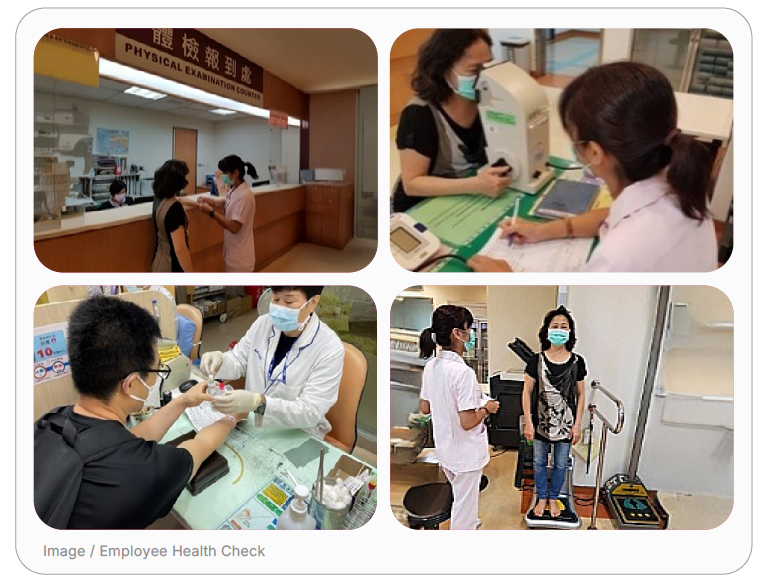
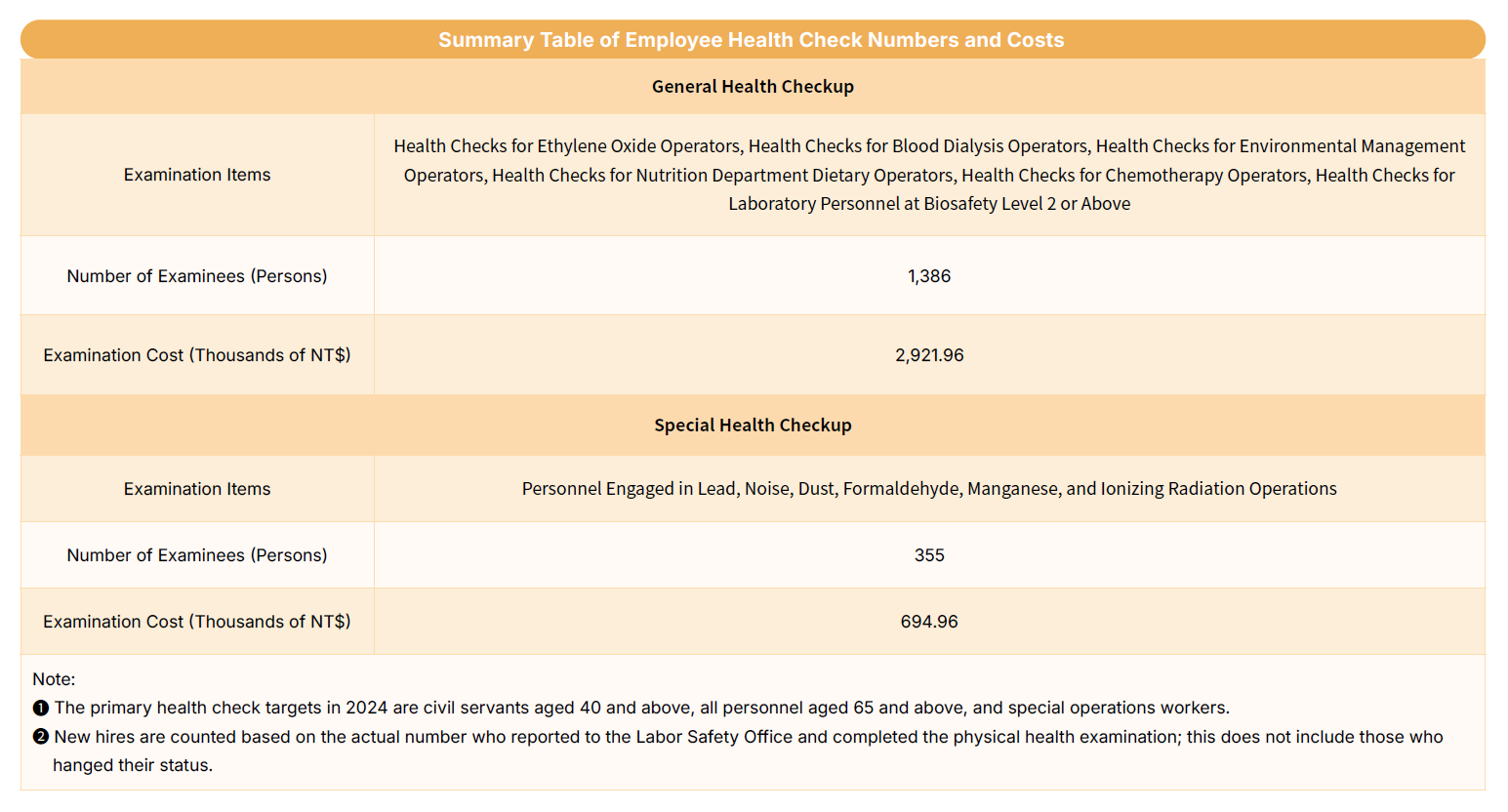
-
Employee Support and Workplace Health Protection
Our hospital implements job redesign through multiple channels to assist employees in evaluating work processes. By integrating resources from administrative units, the training center, and the foundation, customized job redesign services are provided based on employees’ actual conditions. This includes improving the work environment, equipment, and conditions, providing assistive devices, and adjusting work methods to enhance safety and efficiency. In 2024, a total of 8 employees were served, with 7 undergoing job redesign and 1 receiving psychological reinforcement training.
Additionally, the hospital has established a dedicated "Cheng Kung Window" employee suggestion platform with a dedicated hotline as an open communication and feedback channel. Combined with the abnormal workload-induced disease prevention program, the hospital proactively and comprehensively assesses employees’ workload conditions, implements risk grading management, respects employee privacy and autonomy, and provides individual health education and necessary referrals. In 2024, 1,755 employees were assessed, of whom 33 were recommended for further interviews. On-site health guidance was provided 33 times, and on-site physician consultations occurred 3 times.
Regarding employee care, the hospital has established clear procedures for employee care and condolences. Upon receiving reports of various care cases, the supervisor of the involved unit immediately provides care, and the Employee Care Assistance Team takes charge of case handling. If employees require psychological counseling, the Psychiatry Department provides assistance following the mental health counseling service procedures. The Care Team meets quarterly for ongoing care and follow-up, demonstrating the hospital’s continuous attention to and care for employees’ physical and mental well-being.
